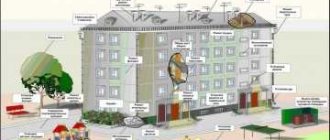Answer
The limit of operational responsibility is determined by agreement of the parties.
If an agreement cannot be reached, then the boundary is determined by the balance sheet boundary. Balance sheet ownership is determined by entries in the state register of rights and other documents in accordance with the law. As a rule, a section of the network within the land plot of the house owner is his property.
The rationale for this position is given below in the materials of the “Lawyer System”
.
"2. These Rules use the concepts defined in the Federal Law “On Water Supply and Sanitation”, as well as the following concepts:
“balance line of ownership” - the line of division of objects of centralized cold water supply and (or) wastewater disposal systems, including water supply and (or) sewerage networks, between owners on the basis of ownership or possession on another legal basis;
“limit of operational responsibility” - a line dividing objects of centralized cold water supply and (or) sewerage systems, including water supply and (or) sewerage networks, based on duties (responsibility) for the operation of these systems or networks, established in a cold water supply agreement, contract water disposal or a single agreement for cold water supply and sanitation, an agreement for the transportation of cold water, an agreement for the transportation of wastewater*.”
Understanding the boundaries of responsibility between the RSO, the management company and the owners of residential premises in apartment buildings is important to avoid controversial situations. In judicial practice, there are often cases of disputes between the RSO and the management company regarding operational responsibility for certain sections of utility networks, regarding which no agreement has been reached.
In half of administrative cases of this kind, the court takes the side of the RSO, in this case the Criminal Code incurs large losses. To avoid this and be insured against unwanted conflicts, you need to draw up an act of delimitation of responsibility.
On the place of delimitation of balance sheet responsibility in the energy sector
The concepts used in these Rules mean the following: “act of delimitation of balance sheet ownership of electric networks” - a document drawn up in the process of technological connection of energy receiving devices (power installations) of individuals and legal entities to electric networks (hereinafter referred to as energy receiving devices), defining the boundaries of balance sheet ownership; “act of delimitation of operational responsibility of the parties" - a document drawn up by the network organization and the consumer of services for the transmission of electrical energy in the process of technological connection of power receiving devices, defining the boundaries of responsibility of the parties for the operation of the corresponding power receiving devices and power grid facilities; "balance sheet boundary" - the line of dividing electric power facilities between owners on the basis of ownership or possession on another provided
What should be the installation distance of electricity meters from the balance sheet boundary or from a residential building?
The electricity consumer, when signing such an agreement, is unaware of possible penalties and restrictions on the supply of electricity from the energy supply organization.
Despite the fact that some such sanctions may not be entirely legal, after signing the agreement by both parties they become legally binding, since in accordance with Art.
You have the right to demand from the energy supplying organization that the electricity meter be installed in the location you require.
Limits of operational responsibility
Not for all corporate entities the legislation clearly defines the boundaries of operational responsibility and the balance sheet inextricably linked with it. These concepts are most clearly presented in clause 1 of the Rules for cold water supply and sanitation (Resolution of the Government of the Russian Federation No. 644).
According to this document, the boundary of the balance sheet is recognized as the boundary of the division of property. It, in turn, determines the boundary of operational responsibility, that is, it indicates who will bear the burden of maintaining the facility: the management organization, the RSO or the owners. The same can be said about other communal resources.
The boundary of the operational responsibility of the RSO, if we are talking about power supply, extends to the point of connection of the common house metering device with the electrical network included in the apartment building. The responsibility of the management company is the in-house power supply system and electrical devices, disconnecting devices for the apartment. The responsibility of residents is internal devices and devices after disconnecting devices in floor panels, meters in apartments.
Responsibility for heat supply is distributed as follows: RSO bears responsibility up to the point of connection of the common house metering device with the heating network included in the apartment building. The management company is responsible for the heating system risers, disconnecting devices on branches from the risers and for shut-off and control valves on the intra-apartment wiring. Residents' responsibility again begins inside their home, they are responsible for heating devices and for branches from the heating system risers after the shut-off and control valves.
The responsibility of the RSO, when it comes to water supply and sanitation, extends to the point of connection of the common house meter with the water supply network included in the apartment building. Management companies are required to monitor the condition of hot and cold water supply risers, shut-off devices on branches from risers and shut-off and control valves on intra-apartment wiring. The owners of premises in apartment buildings are responsible for the branches from the risers of the hot and cold water supply system after the shut-off and control valves, for the shut-off and control valves themselves and for the plumbing equipment in the apartments.
In a resource supply agreement, the balance sheet boundary separates utility networks, which are common property (Article 36 of the Housing Code of the Russian Federation), from other utility networks. Therefore, let us recall what applies to common property (Resolution of the Government of the Russian Federation No. 491, Article 36 of the Housing Code of the Russian Federation):
- premises in apartment buildings that are not parts of apartments and are intended to serve more than one residential/non-residential premises in the house;
- in-house engineering systems for cold and hot water supply, gas supply, heating and electricity supply.
The boundaries of operational responsibility can be external and internal. In the first case, they share the spheres of competence of the RSO and the management company (the external border of the wall of the apartment building), in the second - the management company and the owners (the internal border of the wall of the apartment building).
Heating system risers belong to the common property of the owners of apartment buildings
Ministry of Construction of Russia dated 04/01/2016 N 9506-АЧ/04
It is indicated that, according to paragraph 6 of the Rules for the maintenance of common property in an apartment building, approved by Decree of the Government of the Russian Federation of August 13, 2006 N 491, the common property includes an intra-house heating system, consisting of risers, heating elements, control and shut-off valves, collective (common house) thermal energy metering devices, as well as other equipment located on these networks.
Thus, an in-house heating system is a set of risers, heating elements, control and shut-off valves, a collective (common house) heat energy meter, as well as other equipment located on these networks.
According to the position of the Supreme Court of the Russian Federation, equipment located in an apartment building can be classified as common property only if it serves more than one residential or non-residential premises. Heating elements (radiators) of an intra-house heating system serving only one apartment, including those having shut-off devices (shut-off valves), the use of which will not entail a violation of the rights and legitimate interests of other owners of the premises of an apartment building, are not included in the common property.
At the same time, it is indicated that the composition of the common property of an apartment building in order to fulfill the obligation to maintain it can be determined by the owners of the premises in such a building.
A certain composition of the common property of an apartment building in respect of which management will be carried out is an essential condition of the apartment building management agreement, in connection with which the owners of the premises of the apartment building and the management organization in the apartment building management agreement by drawing up an appropriate annex to the agreement can delimit the area of operational responsibility according to heating system, placing responsibility for the heating elements (radiators) located in a residential (non-residential) premises and serving one premises on the owner of this premises, and responsibility for the risers, disconnecting devices on the branches of the risers, located in the owner’s premises, but serving several premises, - to the management organization.
Go to document text »
Date of publication on the website: 04/04/2016
Share link:
www.consultant.ru
External limits of operational responsibility
If we are talking about the external boundary of utility networks that are part of the common property of an apartment building, then the boundary of operational responsibility between the RSO and the management company will be considered the external boundary of the wall of the house, and if there is a common house meter for a certain utility resource, the place where this common house meter connects with the corresponding engineering network included in the MKD.
Separately, it is worth mentioning the external border of the gas supply networks that are part of the general property of the apartment building. In this case, the boundary of operational responsibility between the RSO and the management company is the point of connection of the first shut-off device with the external gas distribution network.
Often the line of operational responsibility does not run along the wall of the house. Then, a fragment of a utility network located outside the outer wall, which, it would seem, formally belongs to the area of responsibility of the RSO, falls into the zone of the management company managing the apartment building. Its content threatens large losses, so you need to carefully approach the description of the boundaries of operational responsibility in the act of delineation of responsibility.
The case when the boundary of operational responsibility passes along the external valve can be considered controversial. This happens if the external section of the utility network is part of the common property . Then the RSO carries out maintenance of this utility network at a tariff approved by the owners of the premises in the apartment building. The duty of the management company is to offer such a tariff to the owners. Repairs, including emergency ones, are carried out at the expense of RSO.
What about ownerless utility networks ? That is, with such networks that are not on the balance sheet of either the management company or the RSO and are not part of the common property. Typically, such networks are transferred to municipal ownership. In turn, the local government body, within thirty days from the moment of identifying an ownerless utility network, is obliged to determine the distribution network whose utility networks are connected to the ownerless one (Clause 6 of Article 15 No. 190-FZ).
The Federal Tariff Service will have to include the costs of maintaining such a network in the RNO tariffs for further regulation. Until this is done, energy losses in this disputed section of the network, as well as repair work, are carried out at the expense of the management company in proportion to actual consumption.
Features of drawing up the act, general points
If you are tasked with creating an act of delimitation of balance sheet and operational responsibilities, and you have no idea how to do this correctly, we recommend that you carefully read the tips below. Check out the sample document as well - you will probably be able to create your own form based on it.
Today there is no single unified form of the act. This suggests that employees of resource supply companies have the opportunity to write it in any form or, if the organization has an approved document template, according to its type.
Regardless of which method of execution is chosen, when writing the act, it is necessary to take into account several common points characteristic of all such papers. For example, you need to ensure that the structure and content of the form meet certain office work standards.
In other words, the act should be divided into three parts:
- the so-called “header”, where data about the document itself is entered;
- main block - includes data about the supplier and consumer of services, address and some individual technical characteristics of the object, etc. Quite often, a graphically designed layout of communications is also included here (however, it can also be attached as a separate document);
- the conclusion is the fact of approval of the division of responsibility.
The act can be drawn up on an ordinary blank sheet of any convenient format (generally applicable A4), by hand or typed on a computer - these values do not play a role in determining its legality. The only important thing is that the act is drawn up without errors or omissions, and if any do occur, it is better not to correct them, but to draw up a new form.
In addition, the document must be endorsed using seals (provided that their use is enshrined in the company’s accounting policies).
The application is drawn up in three identical copies .
- One is sent to the service consumer,
- the second - to the controlling supervisory structure,
- the third one remains with the resource supplying organization.
The act must be signed by representatives of two parties: the resource supplier and the recipient.
Internal operational boundaries
The boundary of operational responsibility between the management company and the owners, when it comes to the internal boundary of the utility networks that are part of the common property of the apartment building, is:
- for heating - valves on the heating pipeline connections to the apartment radiator. If there are none, then the boundary passes along the threaded connection in the radiator plug.
- for cold and hot water supply - a valve at the pipeline outlet from the riser. If it is not available, the boundary is the weld at the pipeline outlet from the riser.
- for drainage - a socket of a shaped product (tee, cross, bend) on the riser of the drainage pipeline.
- for power supply - the place where the outgoing wire of the apartment electrical wiring is connected to the plug of an individual electricity meter, circuit breaker, RCD.
The boundary of operational responsibility between the management company and the owners (we are talking about the internal boundary of building structures that are part of the common property of an apartment building) is the inner surface of the walls of the apartment, window fillings and the entrance door to the apartment.
The enclosing load-bearing structures, the land plot (including children's and playgrounds, collective parking lots) on which the house is located, landings, corridors, roofs and attics, as well as elevators are in the area of operational responsibility of the management company.
Arbitrage practice
Perhaps the main argument in favor of the importance of discussing in detail the boundaries of operational responsibility in a resource supply agreement will come from examples from judicial practice.
The management organization filed a claim in court to declare the terms of the energy supply contracts invalid and for the obligation to transfer the heating networks to the area of responsibility of the RSO. The court refused to satisfy the claims, since the Criminal Code agreed on the boundaries of the balance sheet, accepting the disputed section of the networks for its maintenance (Resolution of May 23, 2012 in case No. A63-9362/2011).
The court may make a different decision if the boundaries of the balance sheet in the act are indicated differently than along the external wall of an apartment building or at the point of installation of the meter. In this case, the act of delimiting balance sheet ownership is invalid (Determination of the Supreme Arbitration Court of the Russian Federation dated June 26, 2012 N 6421/12 in case N A14-11374/2010).
When concluding the contract, disagreements arose between the parties regarding the limit of operational responsibility, since there was no act of delimitation of responsibility, the court decided to determine the limit of operational responsibility in accordance with the Rules for the maintenance of common property (Resolution of the Arbitration Court of the Central District of May 21, 2015 N F10-1143/2015 in case N A68 -2267/2014).
And according to the Resolution of the Federal Antimonopoly Service of Ukraine dated February 28, 2011 No. Ф09-443/11-С5, in a similar situation of the absence of an act of delimitation of responsibility , the court concluded that the line of operational responsibility should pass along the line of balance sheet ownership, in other words, along the line of division of utility networks between owners.
If you have any questions, you can always contact us for advice. We also help management companies comply with 731 Russian Federation Regulations on the Information Disclosure Standard (filling out the Housing and Communal Services Reform , management company website, information stands) and Federal Law No. 209 ( filling out the Housing and Communal Services GIS ). We are always happy to help you!
When companies managing multi-apartment residential buildings (MCs) enter into contracts with resource supply organizations (RSOs) for heat, water, electricity and gas supply, disputes very often arise about determining the delivery points of the corresponding resource and the boundaries of the operational responsibilities of the parties under the contract.
In order to reduce losses on networks, RSO strives to establish the delivery point as far as possible from the end consumer, which is absolutely unprofitable for the other party to the contract. This article will consider a method for legally determining delivery points and the boundaries of operational responsibilities of the parties.
alishavalenko.ru
Answer: From your question it is not clear where the boundary between the balance sheet ownership and operational responsibility of electrical installations is.
If the boundary of the balance sheet is established in the input distribution device on your site, then the energy supplying organization does not have the right to force you to install an electricity meter outside the land plot, since such electrical installation cannot provide conditions corresponding to the climatic design and category of meter placement, as well as protection from unauthorized access to it.
For the operation of industrial, commercial, office buildings and structures, their owners enter into contracts for energy supply, as well as water and heat supply, sanitation, etc. According to the terms of such contracts, subscriber companies receive for a fee, for example, electricity and are required to maintain the relevant networks in technically sound condition , through which utilities are supplied. However, sharing the burden of responsibility under such contracts, or more precisely, determining its boundaries, is not an easy task and in practice leads to numerous disputes between subscriber companies and supplying organizations.
The design of the energy supply contract is a general contractual model within which the supply of various utility resources is carried out. Accordingly, the general rules on energy supply contracts, enshrined in §6 of Chapter 30 of the Civil Code of the Russian Federation, equally apply to contracts for heat supply, water supply and other contracts for the supply of utility resources by virtue of Art. 548 Civil Code of the Russian Federation.
In addition to the general rules, special rules contained in the relevant regulatory legal acts apply to certain types of such agreements (for example, for a water supply agreement, such a legal act is the Federal Law of December 7, 2011 No. 416-FZ “On Water Supply and Sanitation”).
However, regardless of the type of communal resource being sold (water, thermal energy in hot water, etc.), its supply is carried out within the framework of the same contractual subtype “energy supply agreement”, which belongs to the contractual type “supply agreement”. The latter, in turn, belongs to the contractual type “purchase and sale agreement”. In this regard, in the absence of rules in special laws regulating relations relating to the supply of a certain communal resource, the rules of §1-3 of Chapter 30 of the Civil Code of the Russian Federation, as well as general provisions on obligations and contracts, can be applied to these contracts.
Concepts and regulations.
To begin with, we will determine what is the point of delivery and the boundary of operational responsibility for each type of resource in accordance with current legislation.
The most complete picture of these categories can be formed on the basis of legislative acts regulating the procedure for the supply of electrical energy. Thus, the definition of the delivery point is contained in the Electric Power Industry Rules, approved by Decree of the Government of the Russian Federation dated August 31, 2006 No. 530. This is a place in the electrical network located on the border of the balance sheet ownership of the power receiving devices of the buyer of electrical energy or the person in whose interests he is purchasing it, and is the place fulfillment of the obligation to supply electricity, used to determine the volume of mutual obligations of retail market entities.
As can be seen from this definition, the delivery point is located on the border of the balance sheet, which, in accordance with the Rules of access to services for the transmission of electrical energy, approved by Decree of the Government of the Russian Federation of December 27, 2004 No. 861, is the line of division of electric power facilities between owners on the basis of ownership or possession on another right provided for by federal laws, defining the boundary of operational responsibility between the network organization and the consumer of transmission services (the consumer of electrical energy in whose interests an agreement on the provision of services for the transmission of electrical energy is concluded) for the condition and maintenance of electrical installations.
The boundaries of balance sheet ownership are determined by the act of delimiting the balance sheet ownership of electric networks - a document drawn up in the process of technological connection of energy receiving devices of individuals and legal entities to electric networks.
The limits of responsibility of the parties for the operation of the relevant power receiving devices and power grid facilities are established by the act of delimiting the operational responsibilities of the parties, drawn up by the network organization and the consumer of electric energy transmission services in the process of technological connection of power receiving devices.
The Rules for the Use of Public Water Supply and Sewerage Systems, approved by Decree of the Government of the Russian Federation of February 12, 1999 No. 167, also contain the concepts of boundaries of balance sheet ownership and operational responsibility. In particular, the line of division of elements of water supply and (or) sewerage systems and structures on them between owners on the basis of ownership, economic management or operational management is called the boundary of balance sheet ownership. The boundary of operational responsibility is the line dividing elements of water supply and (or) sewerage systems (water supply and sewerage networks and structures on them) on the basis of duties (responsibility) for the operation of elements of water supply and (or) sewerage systems, established by agreement of the parties. In the absence of such an agreement, the boundary of operational responsibility is determined by the boundary of the balance sheet.
In paragraph 5 of Art. 15 of the Federal Law of July 27, 2010 No. 190-FZ “On Heat Supply” (hereinafter referred to as the Heat Supply Law) also states that the place of fulfillment of the obligations of the heat supply organization is the delivery point, which is located on the border of the balance sheet ownership of the heat consuming installation or the consumer’s heat network and the heat network heat supply or heating network organization or at the point of connection to an ownerless heating network.
Subclause 3 of clause 4 of Art. 17 of the Law on Heat Supply establishes that the responsibility of the heating network and heat supply organizations for the condition and maintenance of heating network facilities is determined by the balance sheet boundary fixed in the act on delimiting the balance sheet ownership of heating networks and the act on delimiting the operational responsibilities of the parties (in the appendices to such an agreement).
According to paragraph 2 of Art. 19 of the Law on Heat Supply, commercial metering of heat energy and coolant is carried out by measuring them with metering devices that are installed at the metering point located on the border of the balance sheet, unless another metering point is specified by the heat supply agreement or the contract for the provision of heat energy transfer services.
Balance sheet limit
One more point... How legitimate is the clause in the technical requirements for electricity metering: “to organize metering at the border of the balance sheet, install a metering panel for a 3-phase input, equipped with an electric meter with OM or PZR-2-3-3 functions. Provide an electric meter with a device (interface) for connecting the electric meter with the developed automated electricity metering system" ?? Maybe this requirement is also redundant?? How is this regulated by law? Maybe everything is limited to a meter with accuracy class 2.0? 10/19/2009 at 08:58 dim,1. In accordance with clause 3.2 of the Electricity Accounting Rules (approved.
Composition of the common property of premises owners in apartment buildings.
From the analysis of the above norms it follows that the boundaries of balance sheet ownership depend on the boundaries of ownership, economic management or operational management of utility networks. Therefore, it is necessary to determine where these boundaries lie.
Due to the fact that the management company enters into contracts with the RSO and acquires the appropriate resources in order to provide public services to citizens, the provisions of the Housing Code of the Russian Federation, the Rules for the provision of public services, as well as the Rules for the maintenance of common property regulate the relationship under the resource supply agreement.
According to paragraph 2 of Art. 162 of the Housing Code of the Russian Federation, under the management agreement for an apartment building, the management company undertakes to provide services and perform work for the proper maintenance and repair of common property in such a building and to provide utilities to the owners of premises in the building. Therefore, it is necessary to determine the composition of the common property of the owners and establish whether the boundaries of the balance sheet ownership of utility networks depend on the composition of the common property.
By virtue of paragraph 1 of Art. 36 of the Housing Code of the Russian Federation, the owners of premises in apartment buildings own, by right of common shared ownership, premises in the house that are not parts of apartments and are intended to serve more than one room in a given house, including basements in which there are utilities, roofs, enclosing load-bearing and non-load-bearing structures home, mechanical, electrical, sanitary and other equipment located outside or inside the premises of the house and serving more than one room, the land plot on which the house is located, with elements of landscaping and landscaping and other equipment intended for the maintenance, operation and improvement of this house objects located on the specified land plot.
In accordance with paragraph 1 of Art. 157 of the Housing Code of the Russian Federation, the amount of payment for utility services is calculated based on the volume of consumed utilities, determined by the readings of metering devices, and in their absence - on the basis of standards for the consumption of utility services approved by the state authorities of the constituent entities of the Russian Federation in the manner established by the Government of the Russian Federation.
Consequently, by accepting the management of an apartment building, the management company undertakes to ensure the supply of utility resources, the volume of which is determined by meter readings, as well as the proper operation of all of the above-mentioned common property of the owners of premises in the apartment building. To determine the point of delivery of the corresponding utility resource in the MKD, it is necessary to determine in what place the metering device should be installed, and also answer the question of where the line of operational responsibility lies and the point of delivery of the resource in the absence of a metering device.
In accordance with clause 3 of the Rules for the provision of utility services, a collective (common house) metering device is a measuring instrument used to determine the volume (quantity) of utility resources supplied to the apartment building.
Owners of premises in apartment buildings (if they choose direct management of apartment buildings) and owners of residential buildings pay for volumes (quantities) of cold and hot water, gas, electricity and heat purchased from RSO, as well as for wastewater services provided, based on meter readings installed at the border of networks that are part of the common property of the owners of premises or owned by the owners of residential buildings, with public infrastructure systems, unless otherwise established by the legislation of the Russian Federation (clause 7 of the Rules for the provision of public services).
Clause 3 of the Rules for the Provision of Public Utilities defines that in-house engineering systems include engineering communications and equipment intended for the provision of public services and located on the premises of an apartment building or in a residential building.
From paragraphs 5, 6 and 7 of the Rules for the maintenance of common property it follows that in-house systems of cold, hot water supply, gas supply, heating and electricity supply, as well as collective (common house) metering devices are included in the common property of premises owners.
According to clause 8 of the Rules for the maintenance of common property, the outer boundary of electricity, heat, water supply and sewerage networks, information and telecommunication networks (including wired radio broadcasting networks, cable television, fiber optic networks, telephone lines and other similar networks) included in the composition of the common property is the outer boundary of the wall of the apartment building (unless otherwise established by the legislation of the Russian Federation), and the limit of operational responsibility in the presence of a collective (common house) metering device for the corresponding communal resource is the place of connection of the collective (common house) metering device with the corresponding engineering network included in the apartment building (unless otherwise established by agreement between the owners of the premises and the utility service provider or RSO).
From the totality of the above norms it follows that the point of delivery of the corresponding communal resource and the boundary of operational responsibility is the external border of the networks that are part of the common property of the owners. According to the general rule, this boundary, in the absence of a collective (common house) metering device, is considered to be the outer boundary of the wall of the apartment building, and if it is present, the point of connection of the collective (common house) metering device with the corresponding DSO network included in the apartment building.
In practice, there are often cases when the common property of the owners does not end at the border of the wall of an apartment building. Accordingly, the delivery point and the boundaries of balance sheet ownership and operational responsibility are not determined by the outer boundary of the wall of the apartment building.
This is consistent with the provisions of Art. 36 of the Housing Code of the Russian Federation, on the basis of which the common property includes, in particular, the land plot on which the apartment building is located, with elements of landscaping and improvement, and other objects intended for the maintenance, operation and improvement of this house, located on the specified land plot. The boundaries and size of this land plot are determined in accordance with the requirements of land legislation and legislation on urban planning.
REMINDER FOR DETERMINING THE LIMITS OF LIABILITY IN MULTIPLE-Apartment RESIDENTIAL BUILDINGS
Good to know
Who is responsible for what?
AUXILIARY PREMISES OF A RESIDENTIAL HOUSE
in accordance with Art. 1 clause 4 of the Housing Code of the Republic of Belarus, auxiliary premises of a residential building mean premises located outside the apartment and intended to ensure the operation of a residential building (lobbies, corridors, galleries, flights of stairs and landings, elevator halls, etc.).
APPROVED
Resolution of the Council of Ministers of the Republic of Belarus 01/27/2009 No. 99
(as amended by the resolution of the Council of Ministers dated May 15, 2013 N 377)
Agreement for the provision of maintenance services for an apartment building
2.1. The performer is obliged:
2.1.1. produce in accordance with technical regulatory requirements
legal acts maintenance of common property and ensure it
maintenance in good condition, including engineering systems:
— power supply (power supply networks from the input switchgear to the floor (apartment) electrical panel, disconnecting and protective equipment for supplying electricity to the apartment)*;
— electric stoves (in terms of electrically safe operation);
- ventilation and smoke ducts (shafts), with the exception of intra-apartment ones;
— cold and hot water supply (distribution pipelines
(risers) and floor, apartment branches from them with the installed first
shut-off valves (valves);
— drainage (sewerage) (general sewer risers);
- central heating (with horizontal wiring - common
pipelines (risers) and floor and apartment branches from them with
installed first shut-off valves (valves); with other methods
wiring - pipelines and heating devices in residential and utility rooms
premises;
— hot water supply pipelines (including heated towel rails installed in accordance with the building’s construction project).
2.2. The consumer is obliged:
2.2.2. maintain the living space, including window and door fillings, loggia (balcony), entrance openings to ventilation ducts in proper sanitary and technical condition, carry out, at their own expense, as necessary, routine repairs of finishing elements of structural elements, as well as timely replacement or repair of worn-out, failed sanitary, gas, electrical or other equipment, repair and replace failed heat distributors and thermostats.
Resolution of the Council of Ministers of the Republic of Belarus dated May 21, 2013 No. 399
Changes and additions:
Resolution of the Council of Ministers of the Republic of Belarus dated April 16, 2014 No. 360 (National Legal Internet Portal of the Republic of Belarus, 04/22/2014, 5/38730)
- Owners of residential premises of a private housing stock, tenants of residential premises of a state housing stock, shareholders who have entered into agreements providing for the transfer to them of ownership and use of shared construction objects, members of the developer organization are obliged to carry out, at their own expense, including with the involvement of specialized organizations, routine repairs of residential buildings. premises (plastering, filling cracks, whitewashing, painting and wallpapering walls, ceilings, painting floors, window sills, window and door fillings, radiators, inserting glass, replacing floors, window and door fillings and their insulation), repairing stoves, as well as replacing and repair of in-house electrical (stoves, electric exhaust fans, water heaters), gas (stoves, boilers, water heaters), sanitary (baths, sinks, washbasins, toilets, flush tanks, faucets) and other equipment (except for the heating system, smoke control system protection and automatic fire alarms), installation, replacement and repair of individual metering devices for the consumption of gas, water, thermal and electrical energy (including those located in auxiliary premises), as well as intra-apartment electrical wiring, with the exception of cases of eliminating defects and malfunctions in residential premises, which appeared as a result of malfunctions of structural elements and engineering systems through no fault of their own.
APPROVED
Resolution of the Council of Ministers of the Republic of Belarus October 17, 2011 No. 1394
Changes and additions:
Resolution of the Council of Ministers of the Republic of Belarus dated October 23, 2015. No. 895.
Electricity rules
Chapter 3
BOUNDARIES OF BALANCE OWNERSHIP OF ELECTRIC NETWORKS
AND OPERATIONAL RESPONSIBILITY OF THE PARTIES
- Responsibility for the condition of contact connections at the border of the balance sheet of electrical networks in multi-apartment residential buildings lies with the energy supply organization.
In an apartment building, the boundary of operational responsibility of the parties to intra-house electrical networks is established: in a group floor electrical panel - at the contact connection of the electrical wiring branch to the apartment, located before the disconnecting and protective equipment installed in this electrical panel. In this case, the organization operating the housing stock and (or) providing housing and communal services (hereinafter, unless otherwise established, the organization operating the residential building) bears responsibility for the condition and maintenance of these contact connections. The owner of a residential premises of a private housing stock or the tenant of a residential premises of a state housing stock is responsible for the condition and maintenance of the individual floor (apartment) electrical panel, branch wiring to the apartment and intra-apartment wiring.
- Calculation metering tools for electrical installations of consumers, including for newly built apartment buildings, are purchased and installed by consumers, customers, and developers in construction activities.
- Responsibility for the safety and integrity of settlement accounting means, including ASKUE, the safety and integrity of seals on settlement accounting means, serviceability and integrity of settlement accounting electrical wiring rests with the citizen who is the owner of these means (instruments, devices).
- Checking the accounting means at the initiative of a citizen using electrical energy for domestic consumption should be carried out upon his application sent to the energy supply organization.
- The energy supply organization, within 5 days after submitting an application from a citizen using electrical energy for domestic consumption to verify the accounting device, ensures the correct operation of the accounting device and, if necessary, sends the device for an extraordinary verification.
Acts of delimitation of balance sheet ownership and operational responsibility.
Due to the fact that the established boundaries of operational responsibility determine which areas of engineering equipment the management company will service, in order to avoid disputes during the execution of the contract between the RSO and the management company, acts delineating balance sheet ownership and operational responsibility must be signed. The following must be taken into account.
Clause 7 of the Decree of the Government of the Russian Federation dated August 13, 2006 No. 491 established that the boundaries of separate land plots within which real estate objects are located, intended for electricity, heat, gas and water supply to the population and sewerage, as well as areas of public easements in within residential areas, microdistricts to ensure unhindered servicing of the specified property, are established by local governments.
Thus, for each apartment building, local authorities must determine the boundaries of the land plot that belongs to the common property of the house. The boundaries of the land plot that is part of the common property of the MKD determine the boundaries of balance sheet ownership and operational responsibility, which must be recorded in the act between the management company and the RSO. Accordingly, if the boundaries of a land plot are larger than the area of the apartment building, the maintenance of engineering communications passing through this land plot is assigned to the management company on the basis of a management agreement.
In what form is the act of delineation of operational responsibility presented?
The act must be carefully and competently worked out, but the state has not established a clear format for its contents. As a rule, companies offer owners a fully drawn up act of delineation of operational responsibilities
, and they sign it without delving into the contents. This act is an annex and addition to the management agreement for an apartment building. And it is necessary to formalize it.
The difference between the concepts of balance sheet ownership and the act of operational responsibility of the parties
Balance sheet ownership is not the same as operational responsibility. It is worth understanding that the boundaries in the document do not always coincide. The line defining balance sheet ownership divides those who actually own the equipment. But those who must maintain the equipment are determined by the act of operational responsibility of the parties
. These two lines are marked in red and blue respectively and should not be confused. Electrical equipment is maintained by a special organization as planned, and its use must be in accordance with the standards.
How to draw up an act of delimitation of operational responsibilities of the parties
The process of completing this document is quite expensive, long and tedious. This is especially due to the fact that its shape changes all the time. The only thing that does not change is the mandatory presence of the names of the parties, the object and the basis for connection to the power grid.
Quickly and inexpensively draw up an act of delimitation of operational responsibilities of the parties
The Center for Energy Solutions and Innovation will help. This company will provide services for obtaining the certificate in a short time and with minimal financial costs. You can submit an application on the company’s website https://site or contact the number indicated in the contacts section.
It is important for the management organization to decide which engineering communications it is responsible for, and which the resource supply organization is responsible for. This issue is, first of all, financial, since the responsible party restores damaged networks and pays off the damage to those affected by the emergency. The separation of communications is carried out using acts of delineation of operational responsibilities. Our article is devoted to the preparation of this documentation.
Ownerless utility networks.
Unfortunately, in practice there are often cases when utility networks are not within the area of responsibility of either party to the resource supply agreement, that is, they are ownerless. In this case, who should maintain these networks and pay for the loss of utility resources in them?
Clause 4 of Art. 8 of the Law on Heat Supply defines: if organizations carrying out regulated types of activities in the field of heat supply operate heating networks, the owner or other legal owner of which has not been identified (ownerless heating networks), the costs of maintenance, repair and operation of such heating networks are taken into account when setting tariffs in relation to these organizations in the manner prescribed by the principles of pricing in the field of heat supply, approved by the Government of the Russian Federation.
In accordance with paragraph 6 of Art. 15 of the Law on Heat Supply, in the event of identification of ownerless heating networks (heating networks that do not have an operating organization), the local government body of a settlement or urban district, before recognizing the ownership of the specified heating networks, within 30 days from the date of their identification, is obliged to determine the heating network organization whose heating networks directly connected to these heating networks, or a single heat supply organization in the heat supply system, which includes such heating networks and which carries out their maintenance and service. The regulatory authority must include the costs of maintenance and servicing of ownerless heating networks in the tariffs of the relevant organization for the next regulatory period.
According to clause 55.1 of the Guidelines for calculating regulated tariffs and prices for electric (heat) energy in the retail (consumer) market, approved by Order of the Federal Tariff Service dated 08/06/2004 No. 20-e/2 (as amended by the Order dated 07/31/2007 No. 138-e/6), if the costs of operating ownerless networks are not taken into account when setting tariffs, the consumer of electrical energy connected to ownerless networks pays for losses of electrical energy in these networks in proportion to his actual power consumption.
Thus, if the section of networks between the wall of the MKD and the networks of the RSO is ownerless, when setting the tariff for the RSO, the Federal Tariff Service must include the costs of maintenance, repair and operation of this section of the networks. Until the costs of operating an ownerless section of the network are included in the tariff, energy losses in this section must be paid by the management company in proportion to actual consumption. In particular, in the Resolution of the Federal Antimonopoly Service of the Moscow Region dated January 11, 2011 No. KG-A41/14529-10, the court came to the conclusion that the consumer is obliged to pay the cost of thermal energy losses in an ownerless section of the heating network in proportion to the actual consumption by other consumers. But at the same time, the responsibility for operating and incurring costs for these networks arises with the RSO.










